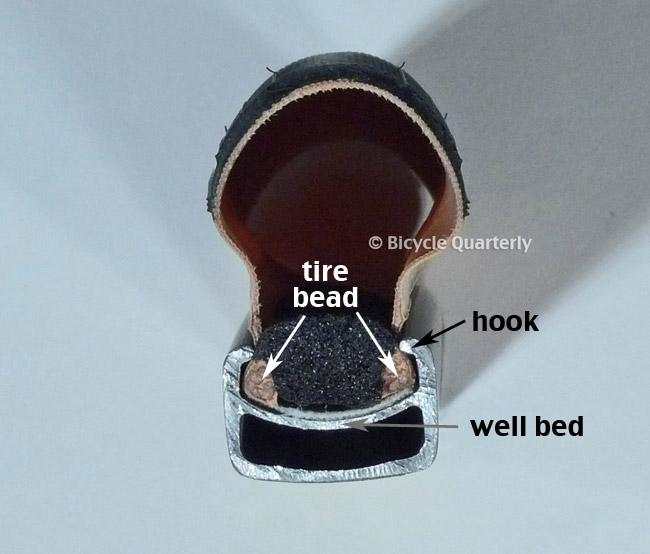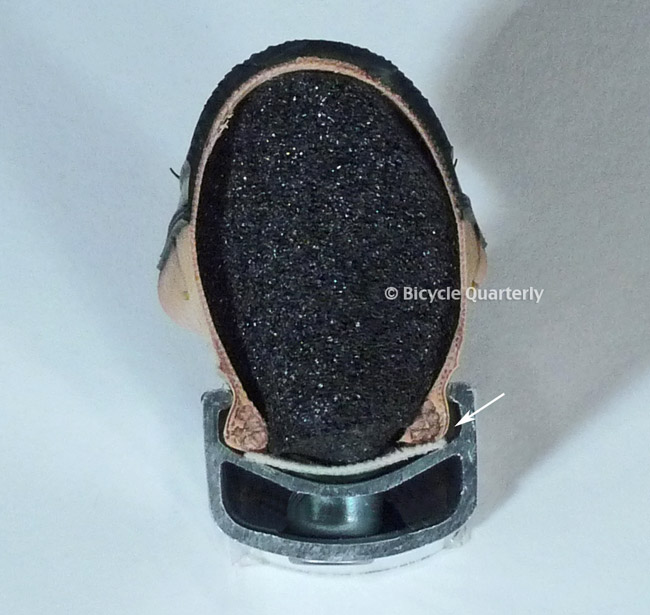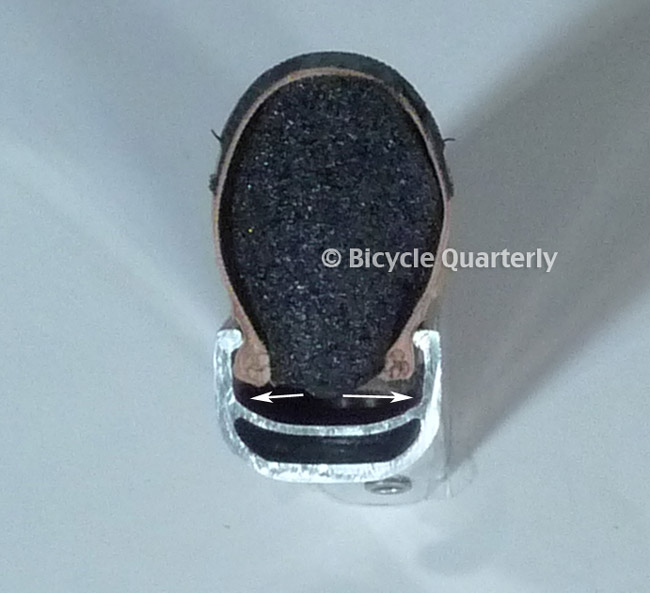Mounting Tires on Rims with Deep Wells

Sometimes we get a call or an e-mail from a frustrated customer: “I have a brand-new set of your tires, and both wobble when I mount them on my rims.” In most cases, it is not the tires’ fault. Usually the problem stems from the difficulty of mounting tires on poorly designed rims. However, there are some tricks for mounting tires on these rims.
Above, you see a correctly mounted tire. Most tires made today have a line molded into the sidewall (arrows). This line must be visible all around the tire, and parallel to the rim edge. The line not only helps seat the tire, it also serves as a visual indicator that the tire is concentric with the rim. (Usually, the line is a little higher above the rim, but always parallel to the rim edge.)

Above are three 700C rims, which all have the same outer diameter. However, the cross sections show that they are very different on the inside. Rim 1 is a proven design. Rim 2 has a shallower well (the place where the tire mounts). Rim 3 has a very deep well. Tires seat differently on each of these rims.

When you mount a tire, the tire beads need to go over the rim’s hook (above; the foam is used to hold the tire in shape). Tire beads are what holds the tire on the rim. They don’t stretch much – otherwise, the tire would just blow off the rim when you inflate it. The well of the rim has a curved bed. When you mount the tire, the tire beads drop into the center of the rim’s well bed. This provides enough slack to get the last bit of tire bead over the rim’s hook on the opposite side. As you inflate the tire, the beads slide up the rim’s curved well bed until they seat tightly underneath the rim’s hooks.
The photo above shows Rim 1. The tire’s beads fit perfectly onto the well bed and underneath the hook. The tire will seat concentrically by itself as you inflate it. The bead seat diameter is 622 mm, as industry standards specify (ETRTO). This is how rims should work.

Rim 2 has a shallower well. The bead seat diameter is 624 mm, which makes the well bed higher than the standard 622mm. To seat correctly, the tire has to stretch by 2 mm in diameter. This translates into 6.5 mm (1/4″) along the tire’s inner circumference, which is a lot of stretch for a tire bead. Often, the beads don’t stretch enough, and don’t quite reach the rim walls (arrow). Then the tire will wobble on the rim. Putting talc (baby powder) on the tire bead may help it slide into position. A very thin and slippery rim tape also can be helpful.
The high well bed also makes the tire difficult to remove: It is difficult to insert a tire lever underneath the tire bead, because it is stretched so tight onto the rim.

Rim 3 has a very deep well. The tire is not supported by the well bed at all (arrows). The tire has to float. When you inflate this tire, it cannot just slide into position on the well bed. You will have to manipulate the tire until it is seated correctly.
Unfortunately, several common rims for wider tires, including the Velocity Synergy, several Velo-Orange models, and the no-longer-available Grand Bois, have overly deep wells. This makes mounting tires difficult. The sole advantage is that the tires come off the rim easily.
On their 650B rims, Synergy tried to “fix” the problem of poorly seating tires by increasing the overall rim diameter. In my experience, this has made things worse, because now the hook is in the wrong place. There is nothing to locate the tire: The well still is too deep, so the tire cannot sit on the well bed. And the hook is too high, so the tire cannot sit underneath the hook.
If you have rims with wells that are too deep on your bike, there are some tricks for mounting tires on them. There even is a “fix” that can overcome the problem of the overly deep wells to a large degree.

On all rims, even well-designed ones, tires often don’t seat well at the valve. The tube is reinforced here, making it stiffer, and it sometimes gets caught under the tire bead. Above, you see how the molded-in line moves away from the rim at the valve. (Often, this is more pronounced.) Not only will this cause the tire to wobble, but if the tube is trapped under the beat, it can chafe until you get a flat tire.

With the tube barely inflated (~5 psi), push the valve stem inward as far as you can. This usually frees the part of the inner tube that is trapped.

Harder to fix is the problem shown above: The line that is molded into the tire sidewall disappears into the rim (arrow). This often happens on rims where the wells are too deep, such as the Synergy Velocity shown here. (The Grand Bois rims we used to sell unfortunately were not much better.) It also can happen if the well is too shallow, and the tire bead does not contact the rim sidewall.

Push the tire to get it into the right place. Inflate it to about 15 psi, and use both hands to push it away from you, until the molded line appears. Go around the tire on both sides until the molded line is visible everywhere and parallel to the rim edge. This takes patience. It can be frustrating, and it’s the last thing you want to do when you have a flat on the road, and all your friends are waiting for you to get back on the road.

To address the problem of the overly deep wells, you can add two layers of rim tape (or handlebar tape, which is the correct width for 23 mm-wide rims). This raises the bottom of the well. Now the tire should seat correctly without as much manipulation.
Do not ride a poorly seated tire! The tire could come off the rim and cause a crash.
Of course, it would be nice to have correctly designed rims, where the tires seat automatically as you inflate the tubes.
Update 3/19/2014: Grand Bois has redesigned their rims with a shallower well, so they fit the tires properly. The new rims are in stock.


